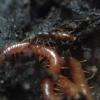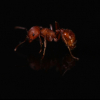- Formiculture.com
- Forums
- Gallery
- Members
- Member Map
- Chat

Formica pallidefulva (Texas)
Started By
Pulliamj
, Apr 9 2015 9:36 AM
47 replies to this topic
#21
 Offline
-
Posted April 9 2015 - 1:57 PM
Offline
-
Posted April 9 2015 - 1:57 PM
I only caught them yesterday; I'm not sure on a setup. They seemed docile at first boy was I wrong. A good video will follow:
#22
 Offline
-
Posted April 9 2015 - 2:01 PM
Offline
-
Posted April 9 2015 - 2:01 PM
#23
 Offline
-
Posted April 9 2015 - 2:16 PM
Offline
-
Posted April 9 2015 - 2:16 PM
My guess from what I can see right now would be Formica dolosa.
#24
 Offline
-
Posted April 9 2015 - 2:28 PM
Offline
-
Posted April 9 2015 - 2:28 PM
That looks right. I was looking for the range or distribution in Texas to make sure it fits too.
#25
 Offline
-
Posted April 9 2015 - 2:31 PM
Offline
-
Posted April 9 2015 - 2:31 PM
The video is much better than the pictures.
I don't see the longer palps that would make this Myrmecocystus.
I think Gaige might be right about them being Formica.
"Always do right. This will gratify some people, and astound the rest." -- Samuel Clemens
#26
 Offline
-
Posted April 9 2015 - 2:42 PM
Offline
-
Posted April 9 2015 - 2:42 PM
Most likely Formica dolosa
Edited by Ants4fun, April 9 2015 - 2:53 PM.
#27
 Offline
-
Posted April 9 2015 - 2:45 PM
Offline
-
Posted April 9 2015 - 2:45 PM
Idk why, that body reminds me of a camponotus.
#28
 Offline
-
Posted April 9 2015 - 2:51 PM
Offline
-
Posted April 9 2015 - 2:51 PM
They have distinct markings on the bottom of their gaster, if you google Formica dolosa, you will notice that they have those same marks, also, I don't believe there are many, if any, Camponotus species that are polygynous.
http://bugguide.net/...w/622456/bgpage
#29
 Offline
-
Posted April 9 2015 - 2:56 PM
Offline
-
Posted April 9 2015 - 2:56 PM
They all have that mark for sure. Do I need to try another video to verify? Or is it for sure Formica dolosa?
I can't find anything saying they have multiple queens in the same nest.
I can't find anything saying they have multiple queens in the same nest.
#30
 Offline
-
Posted April 9 2015 - 2:58 PM
Offline
-
Posted April 9 2015 - 2:58 PM
A lot of formica are polygynous, but to know for sure wether it is Formica dolosa, you should film them with the same thing you filmed your camponotus queen with, It produced a lot clearer video. Unless you were...
#31
 Offline
-
Posted April 9 2015 - 3:00 PM
Offline
-
Posted April 9 2015 - 3:00 PM
I'll try again they move way faster lol. I can't find my tripod either. But I'll try again.
#32
 Offline
-
Posted April 9 2015 - 3:17 PM
Offline
-
Posted April 9 2015 - 3:17 PM
#33
 Offline
-
Posted April 9 2015 - 3:28 PM
Offline
-
Posted April 9 2015 - 3:28 PM
Sure looks like Formica dolosa!
#34
 Offline
-
Posted April 9 2015 - 3:43 PM
Offline
-
Posted April 9 2015 - 3:43 PM
Do you see any white hairs on the thorax of these?
#35
 Offline
-
Posted April 9 2015 - 4:00 PM
Offline
-
Posted April 9 2015 - 4:00 PM
#36
 Offline
-
Posted April 9 2015 - 4:32 PM
Offline
-
Posted April 9 2015 - 4:32 PM
I'm going with Formica pallidefulva.
#37
 Offline
-
Posted April 9 2015 - 4:39 PM
Offline
-
Posted April 9 2015 - 4:39 PM
Very possible...
#38
 Offline
-
Posted April 9 2015 - 4:39 PM
Offline
-
Posted April 9 2015 - 4:39 PM
What's the major difference between pallidefulva and dolosa?
#39
 Offline
-
Posted April 9 2015 - 4:54 PM
Offline
-
Posted April 9 2015 - 4:54 PM
I might be wrong but in that video I think I seen the light reflecting off those hairs that drew speaks of?
#40
 Offline
-
Posted April 9 2015 - 4:58 PM
Offline
-
Posted April 9 2015 - 4:58 PM
I definitely can see hairs on the gaster but I'm not sure about the thorax...
1 user(s) are reading this topic
0 members, 1 guests, 0 anonymous users

















